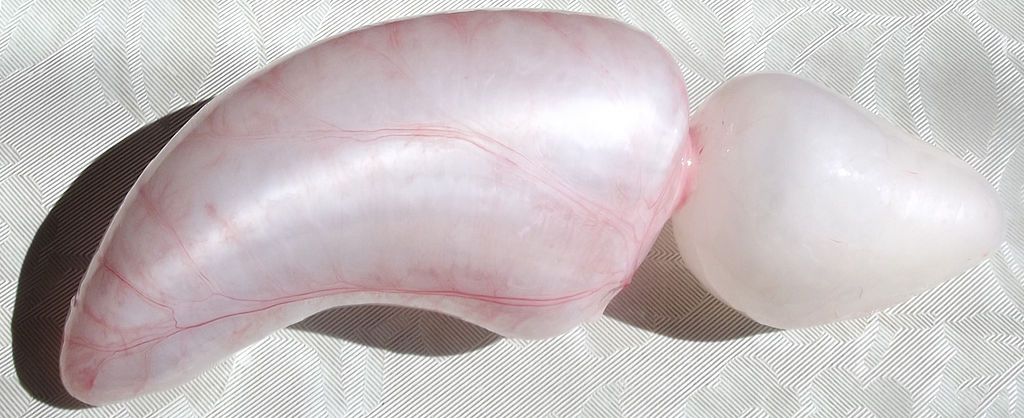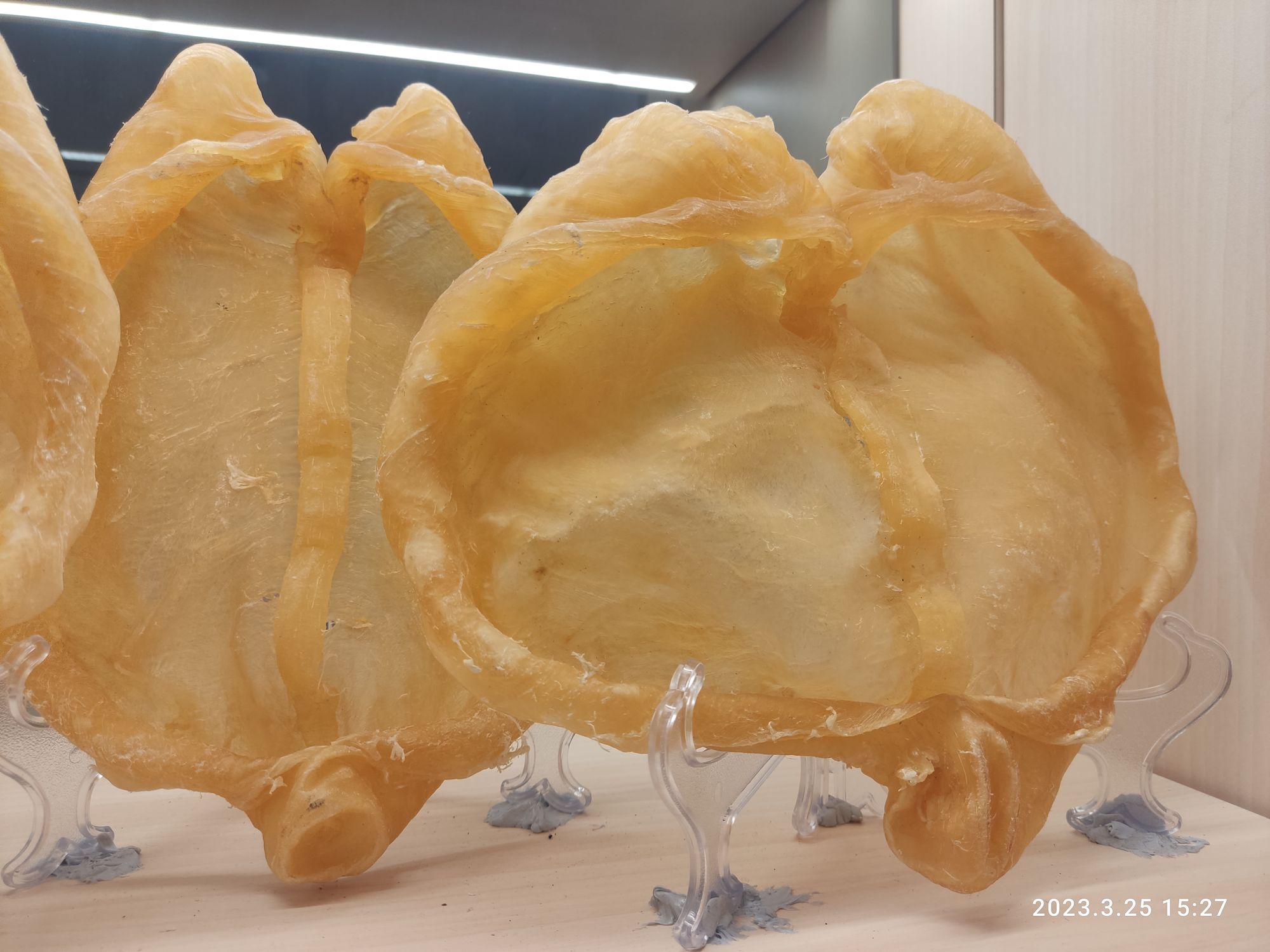Dried Fish Maw: Here's Why It's So Expensive
Revered in Chinese culture, fish maw, priced up to $1,300 per kilogram, is a luxury seafood and a Cantonese "treasure," lauded not only for its culinary prestige but also for its collagen-rich benefits for skin, immunity, and digestion.

Among the world's most expensive dried seafood, fish maw holds a special place in Chinese tradition, with prices spanning $500 to $1,300 per kilogram.
A symbol of luxury and status, it's a coveted gift for grand occasions and a treasured asset.
Listed as one of the "four treasures" in Cantonese cuisine, alongside abalone, sea cucumber, and shark fin, its popularity is fueled by its health benefits.
The maw packed with collagen and fiber, it's believed to boost skin vitality, strengthen immunity, and aid digestion.

What is Fish Maw?
Fish maw, also known as the swim bladder, is an internal gas-filled organ found in many fish. This organ enables fish to regulate buoyancy, ensuring they can maintain their position at various water depths without expending energy.
Beyond its biological function, the swim bladder is rich in gelatine, which lends itself to an array of nourishing health benefits.
In culinary contexts, it's the dried form of this organ that becomes a sought-after ingredient in various dishes, prized not only for its unique texture and flavor-absorbing properties but also for its healthful qualities.
History and Origin
Originating centuries ago in Chinese culinary traditions, fish maw has etched a significant place, particularly as a primary ingredient in soups.
It's not just food; it's an emblem of affluence, and its consumption often graces traditional Chinese festivities and celebrations.
In recent times, its stature as a luxury ingredient has grown, leading to its categorization: the more common 'yu biao' priced around $10 per 100 grams, and the premium 'hua jiao' soaring over $100 for the same weight.
The quality often relates to its source; the swim bladders from deep-sea fish, known for their thicker and gelatinous texture, undergo dehydration or sun-drying.
In contrast, those from smaller fish are typically baked or deep-fried before hitting the marketplace.
Navigating The Best Variety of Fish Maw
Fish maw varies in form, hailing from distinct species and regions like Mexico, Africa, and Norway. Quality indicators include age, color, and thickness, with premium varieties known for their rich collagen.
While dried maw, with its golden hue, is often sourced from larger fish like cod, the fried version, pale-yellow and cylindrical, typically comes from smaller species such as yellow croaker or sturgeon.
Dried maw, celebrated for its soft and springy texture, is perfect for soups and stews. In contrast, the crispy fried maw shines in stir-fry dishes.
However, the surging demand for fish maw has spurred sustainability concerns. Some species, like the croaker, face overfishing threats.
Particularly controversial is the totoaba maw from Mexico, dubbed the "cocaine of the sea." Despite trade bans, its rarity fetches up to US$129,000 per kg in black markets, notably in China.
Maws from male fish, prized for their durability, are preferred by gourmets, as they maintain their integrity even after prolonged cooking, setting them apart from their female counterparts.
Fish Maw: A Culinary Delight
Deep-rooted in Cantonese cuisine, fish maw has become a hallmark in dishes from China, Hong Kong, Singapore, and beyond.
Not only celebrated in Chinese culinary traditions through soups, stews, and braises, this ingredient has found its place in various Asian recipes.
Particularly among women, fish maw soup is lauded for its collagen-rich properties, offering a protein-packed yet non-greasy essence.
What sets fish maw apart is its unparalleled ability to absorb and accentuate flavors, acting like a sponge in culinary creations.
It seamlessly melds with a wide range of ingredients, from meats such as chicken and pork to delicacies like abalone and mushrooms. Adding aromatic spices like ginger and garlic takes its flavor profile to new heights.
Be it in a rich soup, a hearty stew, or a zesty stir-fry, fish maw is the secret weapon that amplifies the gastronomic journey. Dive into varied recipes and find the combination that tantalizes your taste buds.
How Much Is Dried Fish Maw?
Boasting abundant collagen and valued for its therapeutic properties, premium fish maw can command prices up to US$1,300 per kg.
Why is Dried Fish Maw So Expensive?
Fish bladders's elevated price stems from several factors. Primarily, its rarity and limited availability, dictated by specific fish species, drive demand, particularly in certain areas and seasons.
Overfishing of Premium Varieties
Only a few fish species are known for producing the most desired maw, especially large, deep-sea fish such as yellow croaker or sturgeon.
While researching coastal fishing in the 1990s, Bianca Bentes, a professor at the Federal University of Para’s Aquatic Ecology and Amazon Fisheries Centre (NEAP) observed a worrying decline in yellow croaker sizes, with 1.5-metre specimens becoming a rare find compared to the 2.5-metre ones from decades earlier—a clear sign of overfishing.
Historically, the sought-after fish maw came from the Chinese bahaba, a native giant yellow croaker. Its dwindling numbers, post a 1989 trade ban in China, prompted its inclusion on the 2006 IUCN Red List of Threatened Species. As bahaba scarcity grew, the industry shifted to the totoaba, another croaker from Mexico's Gulf of California, imperiling the local vaquita porpoise in the process.
Such overfishing has not only harmed marine ecosystems but also intensified fish maw scarcity, driving its market prices upward.
Processing
Processing the croaker fish maw is an intricate affair. After the croaker is harvested, its swim bladder is expertly extracted and thoroughly rinsed to remove impurities.
This cleaned maw is then briefly blanched, subsequently flattened for uniform drying, and left to air-dry in a shaded, ventilated area for several days.
Once dehydrated, it's graded based on attributes like thickness and size, with premium quality maws being thicker and larger.
To ensure longevity, the dried maw is stored in cool, dry conditions, typically in sealed containers to ward off moisture. This meticulous process ensures the croaker fish maw retains its esteemed culinary qualities.
Nutritional Benefits of Fish Maw
Touted for its medicinal properties, Fish Maw Soup is a nourishing delight offering myriad health advantages. As shark fin trade waned, many have turned to fish maw as a tasty alternative.
This soup is known to reduce inflammation, aid detoxification, bolster the immune system, and help regulate blood sugar. Being low in fat and calories, fish maw emerges as a nutritious seafood substitute. It's protein-rich, fortified with omega-3 fatty acids, vitamin B12, and DHA. Notably, female fish maws turn soft and gelatinous faster than males, making them preferable for quick preparation in fried dishes or soups.
In medicinal beliefs, Traditional Chinese Medicine (TCM) attributes various health benefits to fish maw. It's believed to nourish the yin (cooling aspect) of the body, benefit the kidneys, and boost stamina.
Such medicinal properties further drive up its demand and price.
Flavor Profile
Fish maw itself is subtle and mild in taste. Its strength is in its ability to absorb flavors from accompanying ingredients, making it a versatile addition to dishes.
Texturally, it offers a gelatinous, slightly chewy consistency that's unique and prized in various dishes.
Interesting Facts
- Sustainability Issues: The high demand, coupled with overfishing, has brought attention to the sustainability of harvesting fish maw. Conservationists and gourmets alike are keen on ensuring its ethical sourcing.
- Varieties: Fish maw can be classified into various grades, with factors like size, color, thickness, and species determining its quality and price. For instance, the golden hue maws are especially valued.
- Smuggling and Illegal Trade: Due to its high value, there have been instances of smuggling, especially concerning maws from endangered species like the totoaba (Mexico). This has led to tighter regulations on its trade.
- Culinary Pairing: In many luxury Chinese dishes, fish maw is paired with other revered ingredients like bird's nest, sea cucumber, and abalone, creating a medley of textures and flavors.
Final Thoughts
A robust fish maw's advantage is its extended cooking time, allowing it to deeply imbibe the essence of accompanying ingredients.
While inherently mild, its true charm emerges when simmered with aromatic spices and sauces, where it serves as a flavor enhancer, soaking up nuances like a culinary sponge.
Once adequately cooked, it offers a slick, tender bite. Although fish maw might not be a regular on many plates, its unique texture and flavor-amplifying qualities make it a delicacy worth exploring.


